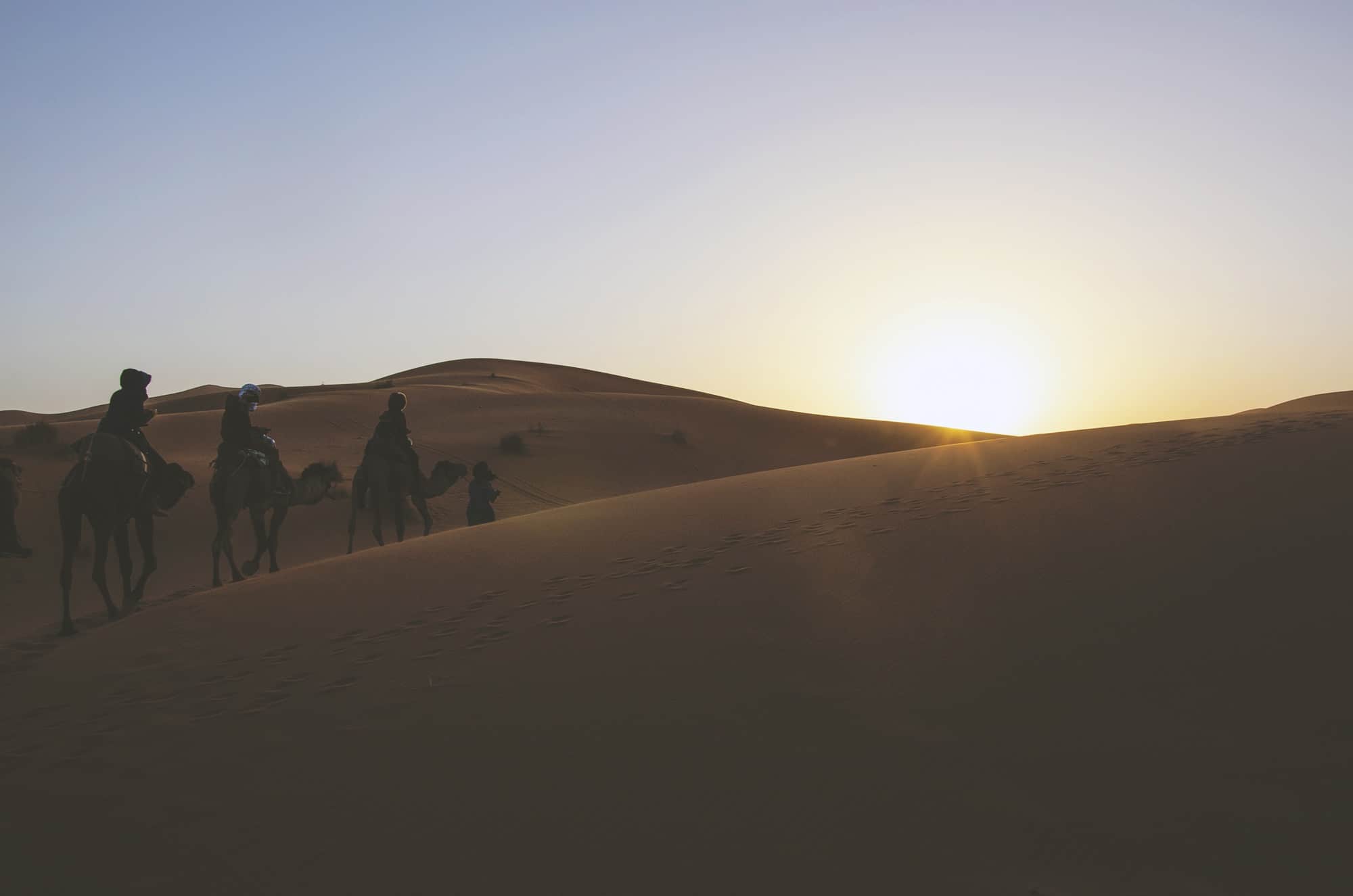So we finally conclude the 42 journeys.
So we finally come to the final chapter in the fourth book of the Torah – the chapter that enumerates the 42 journeys of the Jewish people through the harsh wilderness on their way to the Promised Land. Indeed, the entire chapter is named Massei, Journeys – “These are the journeys…”
This column has been following these journeys as we read through the book of Numbers – in an attempt to decipher the personal application and psycho-spiritual meaning and significance of the 42 journeys – based on The Baal Shem Tov’s teachings that the forty-two journeys in the wilderness, from Egypt to the Promised Land, reflect the forty-two journeys or phases that each person experiences throughout life.
The story till now:
Journeys 1-5: Birth through childhood into the maturity process.
Journeys 6-9: Various adversaries we face early in life.
Journeys 10-12: Power; weakness; revelation.
Journeys 13-15: Craving; rebellion; resignation.
Journeys 16-17: Building family and home.
Journeys 18-19: Failure; mob mentality.
Journeys 20-22: Beauty; fear; unity; community.
Journeys 23-27: Low-points; middle-age; fruits of labor; emissary; counsel.
Journeys 28-33: Later stages of life as we enter old age.
Journeys 34-38: Harsh challenges in the last stages of life’s journey on Earth.
Now we conclude with journeys 39-42, which cover the last stages of life’s journey on Earth, and in general – the final stages of history as we arrive to the “Promised Land.”
These final four journeys are sort of a summation of the entire spectrum of life’s experiences, which can be described as a confluence of extremes: On one hand we are exhausted and worn down from the grueling journeys in the wilderness, with all its pains and difficulties. On the other hand, we can also feel deep appreciation – the satisfaction that is only possible after waging battles – that we have made it through the arduous journeys. Not only have we come out intact, but we can see the fruits of our labor and above all – we now can understand that all the challenges through the 42 journeys were about sublimating and transforming the harsh wilderness, and preparing the ground to enter the Promised Land.
Journey 39: They left the passes and camped in Divon Gad
Divon Gad means a place of good fortune (Targum Yonasan. Rokeach). When the tribe Gad was born to Zilpah – after Leah saw that she was no longer having children – Leah exclaimed “mazal tov (good fortune) has come,” and she thus named the new child Gad (Genesis 30:11 and Rashi). The children of Gad were also powerful people who were triumphant in their battles conquering the Promised Land, as it says “Gad, a troop shall press upon him, but he shall press upon their heel” (Genesis 49:19). Rashi interprets: “Gad, troops will troop forth from him” (over the Jordan River to conquer the Land) and he will triumph “without losing a man” (see Bechayei Genesis 30:11).
Some say that Divon Gad was located on Zered Brook (Baaley Tosafos; Chizkuni Numbers 21:12), where the decree that the Jewish people would die in the desert came to an end (Deuteronomy 2:14). The end of this decree was celebrated as a day of “good fortune” by the Jews and they turned this day into a holiday – the fifteenth of Av (Taanis 30b).
The Zohar (I 244b) says that “the conjunction of the two letters gimmel and dalet (gad) indicates the issuing forth of troops and hosts, gimmel giving and dalet receiving. That river which perennially flows from Eden supplies the needy, and therefore many hosts and many camps are sustained from here; and this is the significance of the name Gad, one producing and giving, and the other collecting and taking.” Gad denotes the power of “gomel dalim” – sustaining the needy, helping the poor and downtrodden, transmitting light to dark places (see Ohr HaTorah Vayechi pp. 382a. Heichel haBrocho Kamarna Massei).
Divon Gad then represents the good fortune stage in our lives when we have triumphed in our battles and prevailed in dire circumstances and now arrive at the end of the process (or the end of life). This good fortune, however, comes with mixed feelings. It is definitely worthy of celebration, but at the same time we also cannot ignore the hard battles and sad deaths up till this point, and that Moses and the generation that left Egypt would not enter, at that point, the Promised Land. Yet, their children will and they will ultimately be reunited with Moses and his generation – thus redeeming all the pain.
Elijah the prophet, who is called “mevaser tov,” the bearer of good news, is from the tribe of Gad. Elijah will be the one that announces the good news that after our backbreaking journeys Moshiach and the Redemption have finally arrived.
In personal terms, Divon Gad, is the life stage when we recognize and acknowledge the blessings of good fortune in our lives. Despite all the setbacks and struggles, notwithstanding the “desolate passes” (in the previous journey), we have refined and elevated the “wilderness” and have arrived with many gifts. We have learned to sustain and nurture (gimmel) the barren and the impoverished (dalet).
Journey 40: They left Divon Gad and camped in Almon Divalthaymah
Almon Divalthaymah is translated as “hidden sweetness” – “the place where the well was concealed from them because they forsook the Torah which is compared to sweet pressed figs” (Targum Yonasan. Rokeach). Some say that this place had many streams where chestnuts and figs grew (Lekach Tov Numbers 21:19).
The mystics explain that Almon Divalthaymah is a state of concealment (Almon from the root he’elem, hidden), referring to the overwhelming existential loneliness that we are all subject to in our lives. How often do we wonder “Am I alone in this world?” “Does G-d hear my prayers?” In fact, however, this feeling of isolation, as real as it may seem to us, is only due to our limited perception. King David teaches us a powerful lesson in this regard.
When David was escaping the wrath of King Saul, he tells his dear friend Jonathan (son of Saul) that as the “new moon” arrives he will go “hide in the field” (Samuel I 20:5). They then agree upon a sign to determine whether David must continue to hide from the pursuing Saul, or he can come out of hiding. When David’s seat will be empty during the meal of the “new moon” and Saul will inquire about his whereabouts, Jonathan should gauge from his father’s reaction whether Saul still wants to kill David or he will leave him me be in peace. Once Jonathan determines Saul’s state of mind, he will come out to the field where David was hiding and “I will shoot three arrows… as if aiming at a mark. And, behold, I will send a lad, saying: ‘Go, find the arrows.’ If I say expressly to the lad, ‘Look, the arrows are on this side of you, get them,’ then come, for it is safe for you and, as G-d lives, there is nothing to fear. But if I say thus to the youth, ‘Look, the arrows are beyond you,’ go your way, for G-d has sent you away. And concerning the matter of which you and I have spoken, behold, G-d be between you and me forever.’”
Once Jonathan saw how his father, Saul’s anger had not subsided and he wanted to kill David more than ever, “in the morning, Jonathan went out into the field at the time prearranged with David, and a little lad came with him. He said to his lad, ‘Run, find the arrows which I shoot.’ The lad ran, he shot an arrow beyond him. When the lad reached the place where Jonathan had shot the arrow, Jonathan said to him, ‘Is not the arrow beyond you?’ And Jonathan cried after the lad, ‘Hurry, be quick, do not stay.’ So Jonathan’s lad gathered up the arrows, and came to his master. But the lad did not know anything; only Jonathan and David knew the matter… As soon as the lad had gone, David came out of a place toward the south, and fell on his face to the ground, bowing three times. They kissed one another, and wept together, until David exceeded. Then Jonathan said to David, ‘Go in peace, seeing that we have both sworn in G-‘s name, saying, ‘G-d be between me and you and between my offspring and yours forever.’” (Samuel I 20:20-23; 35-41).
In a very moving fashion the Arizal (Likkutei Torah Samuel) explains this account as the story of our lives, especially during the dark years of exile, and how it leads to the ultimate redemption. David’s concealment symbolizes the hiding from that we all have to go into from the forces that want to harm us. Jonathan represents the voice of hope and clarity: “I will shoot three arrows… as if aiming at a mark. And, behold, I will send a lad, saying: ‘Go, find the arrows.’” – the three arrows represent the sharp tools we use to hit our mark and refine the material universe. “If I say expressly to the lad, ‘Look, the arrows are on this side of you, get them,’ then come, for it is safe for you and, as G-d lives, there is nothing to fear” – we have reached the point when our “arrows” have integrated matter and spirit, and we no longer have to hide our souls from predators. “But if I say thus to the youth – and here the verse uses the world “elem” (instead of “na’ar), denoting a state of concealment – ‘Look, the arrows are beyond you,’ go your way, for G-d has sent you away” into exile. Sadly, you must remain in hiding and the concealment may even intensify due to the sorry state of a corrupt world.
But the story does not end on this low note. Here the verse continues – and listen to the Arizal’s powerful interpretation: “But the lad did not know anything; only Jonathan and David knew the matter.” The young immature lad cannot see through the concealment, he cannot discern that G-d remains with us even in the darkest moments. Only Jonathan and David “knew the matter” – the truth of the matter, that we never are alone, even when we are in hiding: “And concerning the matter of which you and I have spoken, behold, G-d be between you and me forever.”
Armed with this faith and confidence, the story concludes that David and Jonathan embraced and cried together – “David came out of a place toward the south, and fell on his face to the ground, bowing three times. They kissed one another, and wept together” – these are the outpouring prayers and tears we shed beseeching G-d to deliver us from hiding, prayers that will be fulfilled with the coming of Moshiach ben David – “until David exceeded” and achieves greatness.
This connection gives us the power to transcend the pain and the loneliness – knowing as Jonathan said to David: “Go in peace, seeing that we have both sworn in G-d’s name, saying, ‘G-d be between me and you and between my offspring and yours forever.’”
He 40th journey, Almon Divalthaymah, refers to this existential concealment, which captures one of the greatest challenges throughout all the 42 journeys in the wilderness: will we be able to hold on to the faith and recognize that we even in the arid desert we are traveling toward the Promised Land? Almon Divalthaymah tells us that within the hidden lies enormous reservoirs of sweetness, which we can access by not being myopic children (“the lad did not know anything’), but exerting ourselves to see beyond the shrouds and “know the matter” (Heichel haBrocho Kamarna).
Almon Divalthaymah thus reflects the stage in our lives – usually one that comes with later years or when we are about to reach the end of a long process – when we are faced with this challenge, like a spiral staircase: as we get closer to the summit, to the destination, we must make on final 180 degree turn, which utterly obliterates and conceals the destination, though we are only one step from it.
Don’t be deceived by the dark moment. See it through.
Journey 41: They left Almon Divalthaymah and camped in the Avarim mountains in front of Nebo
Now they arrive to the Avarim mountains, which Moses climbs to see the Promised Land, before he prepares to die and “be gathered up to your people” (Numbers 27:12-13. Deut. 32:49-50).
This is the final journey in all our lives (actually the next to final one) – the transition from life to death. Death obviously is terrible. It symbolizes an end – a disconnection. We associate it with a finality and permanence: We no longer can see and touch, speak and laugh with our loved ones whose souls have departed this plain. Even with deep faith in the soul’s immortality and continued eternal journey, death is absolutely devastating. Even if the soul can see us, we cannot see it.
Yet, yet… the journey does go on. As sad as Moses’ death was – symbolizing that the world remains in concealment – the mountain range is called Avarim, which means “passing through,” or “opposite of” (some say that they were called Avarim because they were opposite the crossing point to Jericho. Others explain that from its peak one could see the burial places of Aaron and Miriam – Zohar 3:183b; Bachya on 20:28, Deuteronomy 32:49).
Death is also a journey – a passage to another place. Though Moses went up the mountain and did not enter the Promised Land, his legacy remained eternal, and the next generation, trained and inspired by Moses, did indeed enter the Land, led by Moses loyal student, Joshua. And here we are today still telling the story, remembering and reliving Moses’ life and his teachings.
Here too we have the paradox of death coupled with knowing that this is a passageway (avarim), and the journey continues. Together with the sadness of Moses’ farewell, we are told that he climbs the Avarim mountains to look at the Promised land – a gaze of a holy man that actually affected and helped refine the land. And that Moses final passage was on Nebo, which consists of two words: nun (50) bo (within). Nebo refers to the 50th gate of wisdom that Moses attained as he climbed the mountain.
So, the journey to the Avarim mountains in front of Nebo, teaches us about our own transitions, especially considering that everyone has a “small Moses” within (Tanya ch. 42). And the challenge we have to balance the antithetical feelings death evokes about the demise of one stage leading and birthing another.
Journey 42: They left the Avarim mountains and camped b’Arvos (in the West Plains of) Moab on the Jericho Jordan. There they camped along the Jordan from Beth HaYeshimoth to Avel Shittim on the West Plains of Moab
In Hebrew b’Arvos Moab literally means in the “darkness” (“arvos” is night and darkness) of Moab – the final, harshest and most difficult of all the journeys in the wilderness (Likkutei Levi Yitzchak Igros, pp. 400). Arvos, however, also means sweetness, referring to the “transformation of bitter to sweet and darkness to light.”
The same dual application applies to Moab: Moab in Hebrew is me-av, meaning ‘from a father’. Spiritually this can have a dual manifestation: A father in the positive sense – a source of sanctity, or a father of evil. In Kabbalistic terms Av (father) is Chochma, which can be either Chochma of kedusha (positive energy), or Chochma of kelipah (negative energy). And these two meaning converge: Ruth came from Moab, and she was the ancestress of King David, and hence, of Moshiach.
Thus, camping b’Arvos Moab sums up the purpose of all the 42 journeys: To transform darkness into light, bitterness into sweetness.
In describing this final journey, the verse continues: On the Jericho Jordan. This refers to the level of Moshiach (Yarden Yereicho: morach v’doyin – Sanhedrin 93b. Likkutei Torah Massei). The Jordan (yarden in Hebrew) is channel that carries from one to another (Baba Metzia 22a), and is also the “lock-key to Israel” – the great revelation of light that is derived from the darkness of Moab.
The verse continues: There they camped along the Jordan from Beth HaYeshimoth to Avel Shittim on the West Plains of Moab – from the wasteland (yeshimon – Numbers 21:20) to the desolate plain (Ramban Genesis 14:6) on the dark plains of Moab.
This final forty-second journey is the final stage of our life’s journey, which both sums up our lives as well as prepares for the transition to the next generation – the one that will enter the Promised Land. It thus describes the summation of all our life’s work – the transformation of a dark and difficult life, setting the stage for the next generation of “Jordan Jericho” – the Messianic redemption.
Our long journey through the wilderness of life – in all its 42 stages – is meant in order for us to tame and refine the world and transform it. This in turn gives us the power to enter the Promised Land – to self actualize and reach our land of promise.
All the 42 journeys are about freeing ourselves and transcending the constraints and limitations (Mitzrayim) of our material existence which conceals the Divine, subduing and sublimating the harsh “wilderness” of selfish existence, and discovering the “Promised Land” – a life of harmony between body and soul.
Just as the first journey was the exodus out of Egypt (Mitzrayim), each of us begins our life journey with birth – the liberation of the fetus from the confines of the womb, where it can develop and become an independent force that has the power to transform the world. The final journey brings us to the threshold of the total transformation of the universe into a holy and “Promised Land.”
Thus all the journeys reflect a dual quality: On one hand they are challenging and difficult experiences journeys. On the other, they all carry great promise and potential, as they allow us the opportunity to refine each of the respective 42 journeys, all leading us to the Promised Land.
This paradox is amplified in the final 42nd journey – the summation of them all, which captures reflects encompasses the entire paradox of life – on one hand the deep darkness, on the other – the power that it gives us to transform the darkness into light. Thus, all the terms used reflect these two extremes.
* * *
So, as we read this week’s chapter, Massei-Journeys, we are reminded that no stage in our lives – and no segment of history – is an island onto itself. Each phase is part of a longer journey, a series of odysseys, leading to a destination.
Simply knowing – truly knowing – that every life experience, even the harshest, is a step leading us to another, better place, everything is on its way to another, better place – this alone can help us get through the loneliest moments.
Awareness of the fact that you are on a journey at all times also infuses each step with profound hope and urgency – to ensure that it will lead us to a destination.
In the historical journey, we are told that we have already endured the 42 journeys and we are standing poised at the “dark plains” on the banks of the River Jordan Jericho boundary, about ready to enter the Promised Land, this time – permanently. Commentaries explain that the opening of this week’s Torah portion, “eleh Massei b’nei Yisroel ” (these are the journeys of the children of Israel) is the acronym: Edom, Modai, Babel, Yovon – the four major exiles and empires that have dominated history (Yalkut Reuveni Massei from Rameh m’Pano, Maamar Chokur Din sec. 3 ch. 22. Chida – Nachal Kedumim).
As we read about our 42 journeys – and try to find the particular journey or journeys we are now traveling through – let us say a toast to each other:
Travel well. The best is yet to come.








dear rabbi jacobson
this was awesome
gary
Mazal Tov for your “Forty- two Journey” completion.
It unfolds a significant part of sacred knowledge.
Though we can hardly appreciate it in full now (all great things used to be better observed from the distance), it can serve today as unprecedented tool for self-discovering and “decoding” main signs and secrets of persons life to maintain harmony between body and soul and, ultimately, to be happy.
Thank you Rabbi Jacobson for giving us the insight to understand how blessed and how purposeful our journey is.
Appreciatively,
Ian
I am on my own small journey and these wise words have shone light into the darkness of the fear that sometimes grips me. How kind of you to explain these things in words that all can understnad.
Although the popular adage has become that life is about the journey and dont forget to smell the roses, it seems important to recognize the destinations. Destinations tell us where we came from, where we are and where we are going. And yes, life is a roller coaster, and the challenge is to stay on the right track. If you hit the wrong track, dust yourself off and get back on the right track. Easier said than done, but that is part of His plan for you.
Thank you Rabbi for this meaningful inspiration and guidance to us hippie generation of baby boomers.
Rabbi,
How synchronistic for me to read this today with the path that I am on.
How wonderfully you brought this all to Life & Light…
Thankyou so much ~ Lezlie
Yashar Koach and thank you for the explanation and illumination.
Motzi Shabbos as I prepare for this new week, I now have greater stength to tackle the challenges that await. You have restored my soul. May Hashem continue to bless all that you do.